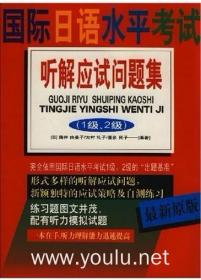
中国翻译话语英译选集 上册:从*早期到佛典翻译
正版全新
¥ 19.83 7.3折 ¥ 27 全新
库存11件
上海浦东
认证卖家担保交易快速发货售后保障
作者张佩瑶 编著
出版社上海外语教育出版社
ISBN9787544617154
出版时间2010-05
装帧平装
开本大32开
纸张胶版纸
定价27元
货号1696090
上书时间2024-05-07
- 在售商品 暂无
- 平均发货时间 24小时
- 好评率 暂无
- 最新上架
商品详情
- 品相描述:全新
- 商品描述
-
【书 名】 中国翻译话语英译选集 上册:从*早期到佛典翻译
【书 号】 9787544617154
【出 版 社】 上海外语教育出版社
【作 者】 张佩瑶 编著
【出版日期】 2010-05-01
【版 次】 1
【开 本】 大32开
【定 价】 27.00元
【编辑推荐】
本书是“国外翻译研究丛书”之《中国翻译话语英译选集(上)》,主要对中国古老的翻译实践及翻译论述的发展脉络作了系统的梳理,并按照时间顺序详尽地展示出一幅宏大的中国传统翻译话语画卷。该书可供各大专院校作为教材使用,也可供从事相关工作的人员作为参考用书使用。
【内容简介】
《中国翻译话语英译选集(上册):从*早期到佛典翻译》系统梳理了中国古老的翻译实践及翻译论述的发展脉络,遵循独特的选、译、评、注原则,按照时间顺序详尽地展示出一幅宏大的中国传统翻译话语画卷。本书的出版对于国际学术界了解中国传统翻译话语具有重要的意义,是中国的翻译论述、翻译研究走向世界征途中的重要一步,对国内的翻译研究,尤其对挖掘中国的传统译论、并对其进行新的解读,是一个颇大的推动。
【目录】
Advisers
Acknowledgements
Map: Lands of the Silk Road: Eastern Aspect at the Beginning of the 21 st Century
Chronology of Chinese Dynasties
Conversion Table: Pinyin to Wade-Giles
About the Editor
About the Translators
Introduction
PART ONE: FROM EARLIEST TIMES TO THE EASTERN HAN DYNASTY (25--220 CE)
OVERVIEW
1
Laozi (b. c. 570 BCE)
ThE CONSTANT WAY (TAo)
From Chapter 1, Tao-te-ching 道德经
2
Laozi (b. c. 570 BCE)
TRUSTWORTHY WORDS ARE NOT BEAUTIFUL
From Chapter 81, Tao-te-ching 道德经
3
Kongzi (Confucius) (traditionally 551-479 BCE)
CLEVER WORDS CAN HARDLY BE PART OF TRUE VIRTUE
From Verse 3, Book 1, Lunyu 论语 (TheAnalects)
4
Kongzi (Confucius) (traditionally 551-479 BCE)
LEARN TO DEVELOP MORAL QUALITIES
From Verse 6, Book 1, Lunyu 论语 (The Analects)
5
Kongzi (Confucius) (traditionally 551-479 BCE)
A LEARNED MAN
From Verse 7, Book 1, Lunyu 论语 (The Analects)
6
Kongzi (Confucius) (traditionally 551-479 BCE)
SUBSTANCE AND ATTENTION TO FORM AND BEAUTY
From Verse 18, Book 6, Lunyu 论语 (The Analects)
7
Kongzi (Confucius) (traditionally 551-479 BCE)
THE ABSOLUTE ESSENTIAL
From Verse 7, Book 12, Lunyu 论语 (TheAnalects)
8
Kongzi (Confucius) (traditionally 551-479 BCE)
SINCERITY IS ALL-IMPORTANT
From Verse 18, Book 15, Lunyu 论语 (TheAnalects)
9
Kongzi (Confucius) (traditionally 551-479 BCE)
GET YOUR MEANING ACROSS
From Verse 41, Book 15, Lunyu 论语 (TheAnalects)
10
Kongzi (Confucius) (traditionally 551-479 BCE)
HE WHO IS SINCERE WILL BE TRUSTED
From Verse 6, Book 17, Lunyu 论语 (TheAnalects)
11
(Attributed to) Kongzi (Confucius) (traditionally 551-479 BCE)
How MUCH USE CAN THERE BE IN A MINOR ART?
From "Xiaobian"小辨 (Minor Arts), Chapter 74, Da Dai liji 大戴礼记 (Elder Dai's Book of Rites)
12
(Attributed to) Kongzi (Confucius) (traditionally 551-479 BCE)
THE RELATIONSHIP BETWEEN LANGUAGE AND MEANING
From "Xici zhuan shang" 系辞传上 (Appended Statements, Part 1, Chapter 12), Zhouyi 周易 (Zhou Changes)
13
(Attributed to) Kongzi (Confucius) (traditionally 551-479 BCE)
ThE MAN OF TRUE VIRTUE
From "Wenyanzhuan qianjiusan" 文言传·乾九三 (Sayings on Patterning [with reference to] the Third Line of Hexagram 1, Qian or Heaven), Zhouyi 周易 (Zhou Changes)
……
Biographies of Persons Mentioned in the Text
Works Cited
References
Title Index
Name Index
General Index
【文摘】
FOOTNOTES
j line between thick translation and translation that is merely thick being extremely fine, hard isions have to be made as to when footnotes should be relied upon for contextualization and en they can be used economically. In this anthology, footnotes explaining the meanings of idhist concepts and Buddhist technical terms are kept to a minimum, on the assumption that ders are more interested in discourse on translation than in Buddhism. Likewise, assuming :readers are primarily English-speaking, few footnotes have been provided on interpretation blems posed by typographical discrepancies between different editions of the same work, 3y different possible ways of punctuating the Chinese text. The exceptions are when the □graphical or punctuation discrepancies give rise to variant, equally valid interpretations, as example in the Buddhist monk Yan Cong's On the Right Way. This text contains Ten Guiding iciples on translating; but owing to two equally valid ways of punctuating the Chinese sage, two of the Principles differ in meaning, thus calling for explanation in a footnote (entry n.219).
Part One (which consists of historical records and passages from canonical texts deployed for orical contextualization, grounding, layering, and for the setting off of semantic reverberations 'art Two) has a large number of footnotes. Basic information which cannot be assumed in a -Chinese readership must be provided if readers are to have a sense of the cultural tradition ,hich discourse on sutra translation is rooted. Similarly, footnotes necessary for understanding main text, and footnotes that can help to throw light on people's way of thinking about slation, are provided as often as necessary. In the interests of smooth reading, a few footnotes e been repeated where appropriate.
ANACHRONISMS
3 in the interests of facilitating reading, a few generalized terms and expressions have been )loyed even though they may be considered anachronistic, or lacking in exactness, or taken xamples of thin translation. Two such terms are "China" and "Chinese". These are used quite ely, as explained below, but it is hoped that readers will appreciate them for what they are: first an expedient measure to facilitate the flow of the narrative, and the second an indication n ideological position.
n the English-speaking world, China (Zhdnggud中国)is generally thought of as a country i a civilization of about five thousand years. Strictly speaking, the territory now thought of :hina did not come into existence until the Qin Dynasty (221-207 BCE) first unified the ous states lying within the geographical boundaries of present-day China. Before that, there i a number of separate states located in the Central Plain (the Yellow River Valley, includ-what is now most of the areas of Henan Province, the western part of Shandong Province, ei Province, and the southern part of Shanxi [Hanyu dacidian 1995(1):600]). These states, :h had strong clan affiliations and were hence culturally interrelated, were known collectively Zhdnggud"中国,literally "Central States". Strictly speaking, therefore, the term "Central es" should be used when one is referring to Zhdnggud in the pre-unification eras. However, e what is involved is not just the term "China" but also the term "Chinese" (the adjective of……
— 没有更多了 —













以下为对购买帮助不大的评价